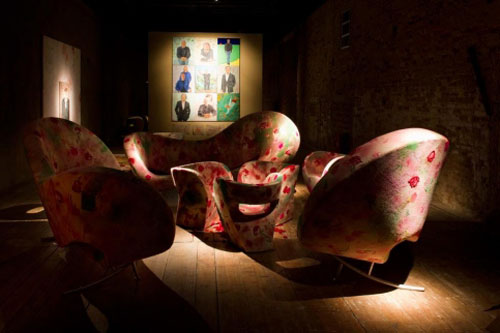ONLY BE VENETIAN
Only-Be Venetian
Exhibit by Nuala Goodman in Venecia
The prolific artist Nuala Goodman presents her fascinating work in the Palazzo Fortuny in Venice until January 9, 2011. Born in Dublin, Ireland in 1962, she studied fine arts at the National College of Art and Design in her hometown, which gave her the foundation to start exploring the world of art and design. Concerned with the intersections between different forms of expression such as art, design and fashion, Goodman has been combining different disciplines without fear and since she took her first steps in the arts,. And thanks to her interesting and fruitful interdisciplinary procedure, Goodman has been able to test not only her artistic skills, and ability to think big, but also helped break down the idea that a strict separation of creative disciplines somehow legitimizes artistic practice. With the exhibition “Gardens” which opened at the Palazzo Fortuny on September 4th, the artist offers us entry to her unique imagery, splashes of color and rich textures. Equipped with an incredible sensitivity to color and composition, Goodman combines different materials and colors to create a complete installation which consists of work designed exclusively for this exhibition. Always keeping in mind the viewer, the exhibition provides an experience which is not just intellectual and is above all, sensory, inviting spectators to touch and explore it up close. Besides this, the exhibition features miscellaneous drawings, doodles and designs of the artist. For more information about the exhibition visit: www.museiciviciveneziani.it Heloise Battista Nuala Goodman is especially known for her work exploring the juncture of fashion, design and art. Come see her conclusions for yourself by renting apartments in Venice Translated...Sweet Dreams of Venice
Once upon a time, a group of Italian journalists was astonished when a distinguished art critic in town for the Venice Biennale and known for her affection for the city did not include it amongst her favorites, something they all took for granted. The writer replied that she did not consider Venice a city but rather, a dream. I remember when I heard this story at the Cafe Florian, my eyes were looking for some evidence of reality on the other side of the glass window overlooking the Piazza San Marco. I recall the glimmering facade of Canaletto Doge´s Palace, shimmering in the mirror of the water. Glancing back at my marble table and thinking that, although he had never paid so much money for a cappuccino, it was perhaps the cheapest cup of coffee I would drink in my life.. There is a sense of living a lucid dream every time you rent apartments in Venice. That same almost nomadic quality of resting in the liminal territory between two planes of existence seems to scent much of the literature and life inspired by the city, ever since Marco Polo. His cellmate surely felt the sense of being penetrated in a dream when he first spoke, feverish, about his travels. Unless, as suggested by the historian Frances Wood, his dream was another, a mere reflection, and Marco Polo never even made it to China (why would he mention paper money but leave out other key details of Chinese life like chopsticks and foot binding?). Perhaps his tale was simply a cooperative dream tinged with elements of stories heard of...The Seven Trumpets, the Seventh Seal of the Book of Apocalypse
The Seventh is the last of the Seven Seals of the Book of Revelation (the last book of the New Testament). All describe terrible prophecies for the earth. The first four seals are those of the four Horsemen of the Apocalypse, predicting false prophets, wars, famine and death, respectively; the Fifth Seal is the one of the Great Tribulation, which predicted indiscriminate persecution against the Christians; the Sixth Seal describes natural disasters and, finally, the Seventh Seal is the one of the Seven Trumpets, each one equivalent to a terrible plague. The Seventh Seal is divided into several stages, each of them corresponding to a Trumpet. Every time a Trumpet sounds, a plague is launched upon the earth: the first four are described as strong winds that whip across the globe. The Fifth and the Sixth will bring more war (presumably the two phases of the Third World War which is yet to come). The last three Trumpets – the Fifth, the Sixth and the Seventh, are called Woes. These are the Seven Trumpets: The First Trumpet: there came hail and fire mixed with blood, and it was hurled down upon the earth. A third of the earth was burned up, a third of the trees were burned up, and all the green grass was burned up; The Second Trumpet: something like a huge mountain, all ablaze, was thrown into the sea. A third of the sea turned into blood, a third of the living creatures in the sea died, and a third of the ships were destroyed; The Third Trumpet: a great star, blazing like a torch, fell...Pop art remains popular
Can you imagine Leonardo Da Vinci visiting an exhibition of Pop Art? The evolution of art is really incredible. We have gone from singular works of art to consumer products and the uniqueness of the work to its reproduction in series.

 English
English Français
Français Deutsch
Deutsch Italiano
Italiano Español
Español






